43 Top Blogging Statistics For 2024 (Latest Facts And Trends)

Curious about a few blogging statistics, such as how many blogs exist in the world and how many words you need in order to write the perfect blog post?
Blogging is one of the oldest forms of digital marketing, and it’s still pretty influential even as short-form video dominates the marketing industry.
In this post, we list the latest blogging stats, including blogging trends and marketing statistics.
Editor’s top picks – blogging statistics
Some of the best blogging stats from this post:
- The web is home to over 600 million blogs. (WebTribunal)
- 42.2% of a blogger’s income is generated through affiliate marketing. (RankIQ)
- 61.1% of B2B companies who have blogs choose WordPress. (Backlinko)
- The average blog post length is 1,427 words. (Orbit Media)
- The food blog niche has a median monthly income of $9,169. (RankIQ)
- 45% of marketers who use AI use the technology as a way to generate content ideas and inspiration. (HubSpot)
General blogging statistics
1. The global content marketing industry will reach a market size of $2 trillion by 2032
The market size for the global content marketing industry will reach $2 trillion by 2032, according to an analysis of the market conducted by Allied Market Research.

The market size for this industry was valued at $413.2 billion in 2022.
It’s expected to grow at a compound annual growth rate (CAGR) of 16.9% between now and 2032.
However, it’s important to note that “content marketing” encompasses a variety of different sources, not just the blogging industry.
It can also mean content creation done for social media and podcast platforms.
Source: Allied Market Research
2. There are over 600 million blogs online
There are over 600 million blogs on the web, according to WebTribunal.

Even more surprising is that 86.33%, or 518 million, are hosted by Tumblr.
10%, or 60 million, are hosted by WordPress.
Source: WebTribunal
3. More than 6 million blog posts are published every day
WebTribunal’s data states that over 6 million blog posts are published on a daily basis.

This works out to 42 million posts being published per week, 180 million per month and 2.19 billion per year.
Source: WebTribunal
4. 18% of internet users read blog posts on a daily basis
In a recent survey, consumers were asked how often they read blog posts.
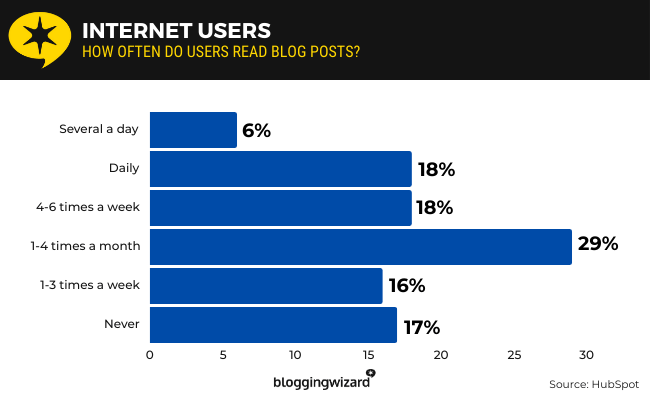
While the majority of internet users, or 29%, read blog posts one to four times per month, 18% read them daily.
However, 17% reportedly never read blog posts.
16% read blog posts one to three times per week while 14% read them four to six times per week.
6% read blog posts several times a day.
Source: HubSpot1
5. Less than 10% of blogs on the web generate an income
WebTribunal’s data states that there are 600 million blogs on the web.
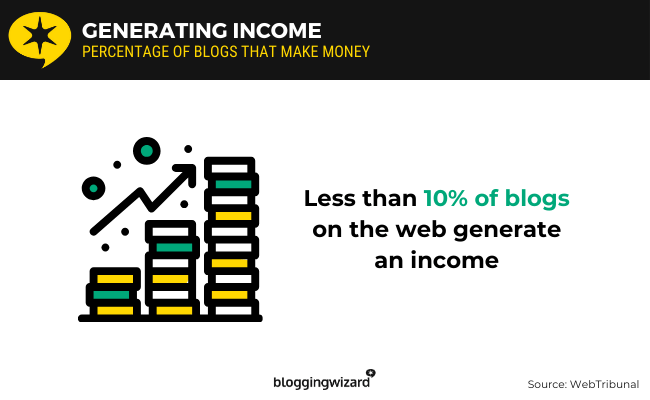
And yet, fewer than 10%, or 60 million, are actually generating revenue.
Source: WebTribunal
6. 82% of bloggers say their blogs deliver results
In Orbit Media’s survey of over 1,000 bloggers, 56% say their blogs deliver “some” results while 26% say they deliver “strong” results.
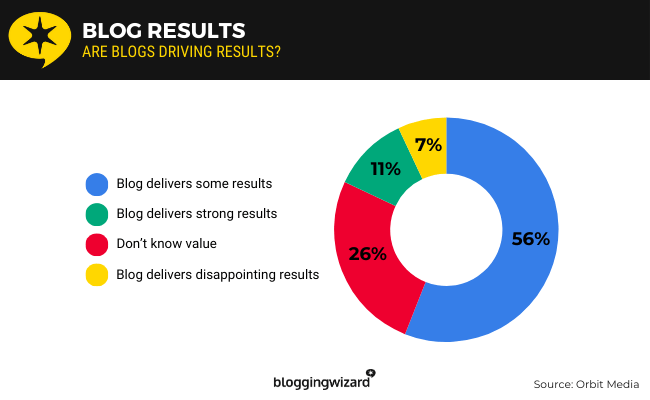
This is in spite of the fact that fewer than 10% of all blogs actually generate some sort of income.
7% say their blogs deliver “disappointing” results while 11% aren’t sure.
Source: Orbit Media
7. 71.7% of B2B businesses have blogs
Backlinko analyzed the websites of 502 business-to-business (B2B) blogs and discovered that 71.7% have blogs.
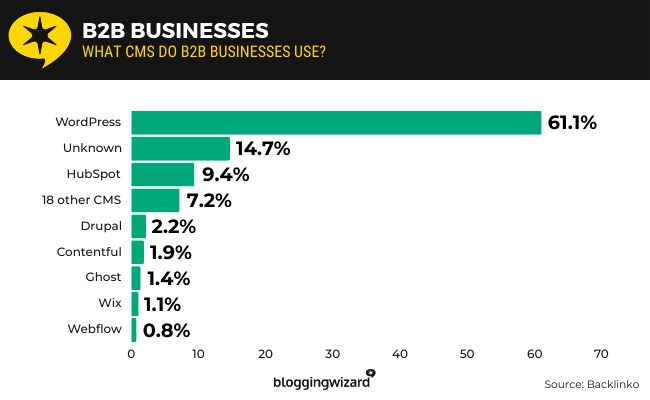
28.3% do not.
Source: Backlinko1
8. 15% of marketers say their website and content marketing had the biggest returns on investment in 2023
According to a survey of over 1,400 marketers, 16% of marketers say their website or blog had the highest return on investment (ROI) out of all marketing channels in 2023.
14% say content marketing had the highest ROI.
Source: HubSpot2
9. 61.1% of B2B blogs use WordPress
Of the 360 B2B blogs Backlinko analyzed, a wide majority, or 61.1%, use WordPress.
This represents 220 blogs out of the 502 B2B companies Backlinko analyzed.
Other popular content management systems were HubSpot (used by 9.4% of B2B blogs), Drupal (2.2%) and Contentful (1.9%).
Source: Backlinko1
10. 49% of bloggers struggle to get readers to engage with their content
The majority of bloggers struggle to get readers to engage with their posts, according to Orbit Media’s survey.
46% struggle to attract visitors from social media while 43% struggle to attract them from search engines.
19% of bloggers struggle to get email subscribers to visit their website from emails.
Source: Orbit Media
11. 24% of bloggers publish blog posts on a weekly basis
According to Orbit Media’s survey, the majority of bloggers publish new posts on a weekly basis.
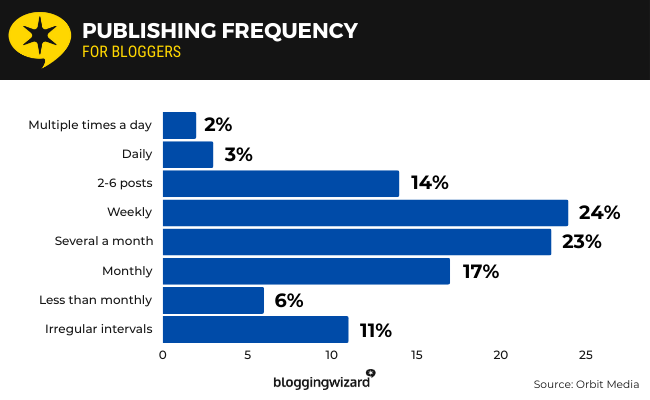
23% publish several posts per month while 17% publish monthly:
- Multiple times a day – 2% of bloggers use this posting schedule
- Daily – 3%
- 2 to 6 posts per week – 14%
- Weekly – 24%
- Several posts per month – 23%
- Monthly – 17%
- Less than monthly – 6%
- Irregular intervals – 11%
The report goes on to say that 57% of bloggers who see strong results from their blogs publish daily.
However, Orbit Media did clarify that no blogger they surveyed is publishing 3,000-word posts on a daily basis.
Source: Orbit Media
12. 38% of website visitors alternate between deep reading and skimming when reading blog posts
According to HubSpot’s survey of internet users, 38% maintain an even mix of deep reading and skimming.
35% skim most of the time while 13% deeply read more often than they skim.
8% immediately skip to the information they’re looking for but remain on the page.
6% skip to the information they’re looking for, then leave.
Source: HubSpot1
Blog optimization statistics
13. Bloggers generate 42.2% of their income from affiliates
RankIQ conducted a study on bloggers and blog niches.
They discovered that professional bloggers generating between $7,500 and $25,000/month generate most of that income, or 42.2%, from affiliates.
They generate 33.3% from ads.
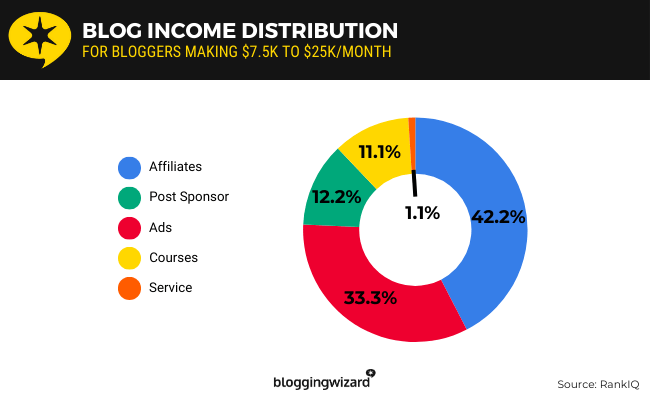
Lesser amounts come from sponsors (12.1%), courses (11.1%) and services (1.1%).
Source: RankIQ
14. 40% of bloggers making $2,000/month or more use the Mediavine ad network
According to RankIQ’s study of blog niches, the majority of bloggers who make $2,000 or more per month choose Mediavine as their ad network.
32% use AdThrive while just over 20% use AdSense.
Fewer than 10% of these bloggers use Monumetric.
Source: RankIQ
15. 65% of B2B blogs use stock images
According to Backlinko’s analysis, the majority of B2B blogs use stock images in their posts.
21% use custom images. 14% don’t use images at all.
Source: Backlinko1
16. The average blog post is 1,427 words long
Orbit Media’s report states that the average blog post is 1,427 words long.
This is a 76.61% increase from 2014’s average of 808 words.

Here’s the full distribution of blog post lengths and what percentage of bloggers use each one:
- Fewer than 500 words – 5% of bloggers write blog posts that are fewer than 500 words each
- 500 to 1,000 words – 31%
- 1,000 to 1,500 words – 30%
- 1,500 to 2,000 words – 20%
- 2,000 to 3,000 words – 11%
- 3,000+ words – 3%
Furthermore, blog post length is directly tied to a blogger’s success.
53% of bloggers who see strong results from their blogs regularly publish blog posts that are more than 3,000 words.
Source: Orbit Media
17. It takes three hours and 51 minutes to write a blog post on average
According to Orbit Media’s survey, it takes bloggers three hours and 51 minutes to write blog posts on average.
This is a 60.42% increase from Orbit’s 2014 survey, which revealed that the average blog post takes two hours and 24 minutes to write.
Source: Orbit Media
18. 76% of bloggers publish how-to articles
How-to articles are the most popular type of content bloggers publish. In fact, 76% of bloggers publish these types of articles.
55% publish lists, 47% cover news and trends, and another 47% publish long-form guides and ebooks.
Here’s how these content types compare to others:
- How-to articles – 76% of bloggers publish this type of content
- Lists – 55%
- News and trends – 47%
- Long-form guides and ebooks – 47%
- Opinion – 43%
- Gated content – 30%
- Webinars – 20%
- Interviews – 26%
- Infographics – 26%
- Roundups – 23%
Source: Orbit Media
19. 58% of marketers list lack of resources as a situational challenge they face with B2B content creation
Content Marketing Institute asked B2B marketers about situational challenges they face when creating B2B content.
58% name lack of resources as the biggest challenge teams face when creating B2B content.
Here are other situational challenges marketers face when creating B2B content:
- Lack of resources – 58% of B2B marketers list this as a challenge
- Aligning content with the buyer’s journey – 48%
- Aligning content efforts across sales and marketing – 45%
- Workflow issues/content approvals process – 41%
- Accessing subject matter experts – 39%
- Keeping up with new technologies – 34%
- Lack of strategy – 25%
- Keeping up with privacy rules and regulations – 19%
- Technology integration – 19%
Source: Content Marketing Institute
20. Only 29.4% of B2B blogs allow blog readers to leave comments
Many websites have their comment sections turned off. Many news sites removed theirs entirely about a decade ago.
Spam and a need to moderate comments manually are two big reasons why companies choose to remove their comment sections altogether.
The move is also popular among B2B companies.
In Backlinko’s study, they discovered that only 29.4% of these companies have their comment sections turned on.
Source: Backlinko1
Content marketing statistics
21. 39% of B2B blogs use related articles as a call to action
In Backlinko’s analysis of B2B companies, they studied the calls to action (CTAs) these companies use in blog posts.
Of the 360 companies who have blogs, 39%, which was the majority, use related articles as a call to action.
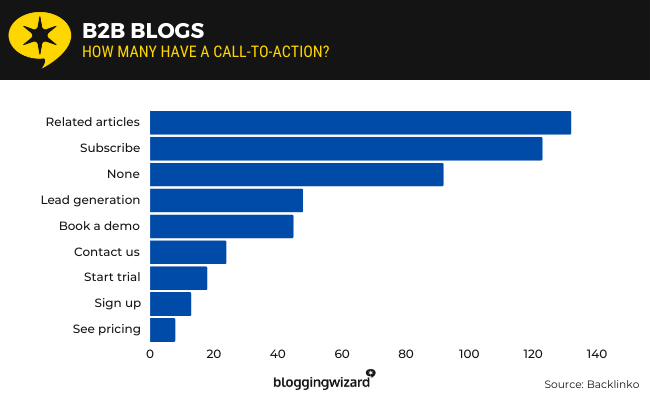
35% use their newsletter subscriptions as a CTA while 23% don’t use CTAs at all.
Other popular CTAs include lead generation-based CTAs, demos, contact and trials.
Source: Backlinko1
22. Educational B2B blogs generate 52% more organic traffic than company-focused blogs
In Backlinko’s study of 502 B2B companies, 360 of which had blogs, they discovered that 51% of companies use their blogs to publish educational content, company news and industry news.
38% use them to publish educational content exclusively.
Backlinko also discovered that companies who produce educational content for their blogs receive 52% more organic traffic than companies who only publish company news.
Source: Backlinko1
23. 15% of marketers say generating traffic and leads is the biggest marketing challenge they face
HubSpot asked over 1,400 marketers about the biggest challenges they face in marketing.
15%, which was the majority, say they struggle to generate traffic and leads, two things an optimized blogging strategy can help you achieve.
Here are other challenges marketers face:
- Generating traffic and leads – 15% of marketers find this aspect of marketing challenging
- Keeping up with trends – 15%
- Understanding customers and their needs – 14%
- Having low-quality data – 14%
- Achieving sales-marketing alignment – 14%
Source: HubSpot1
24. 15% of marketers struggle to create content that attracts more web traffic
HubSpot asked marketers about the struggles they face with content marketing.
Although 16% say they struggle to find new ideas for content, 15% struggle to generate website traffic with their content.
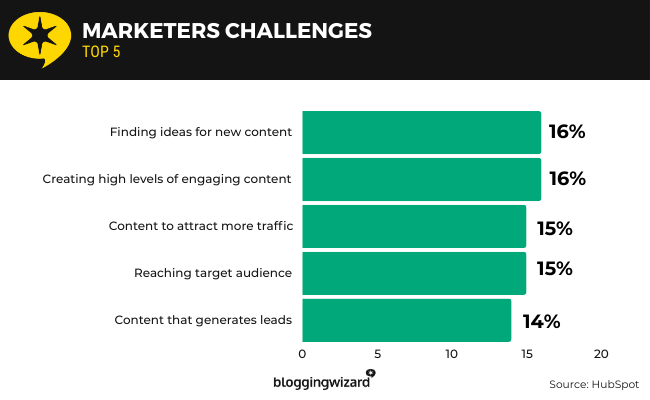
Here are other challenges marketers face with content marketing:
- Finding ideas for new content – 16% of marketers struggle with this aspect of content marketing
- Creating content that receives high levels of engagement – 16%
- Creating content that attracts more traffic to your website – 15%
- Reaching your target audience – 15%
- Creating content that generates leads – 14%
Source: HubSpot1
25. 21% of social media marketers use social media to drive traffic to their websites
HubSpot asked over 1,200 social media marketers about their goals for social media marketing.
21% of these marketers say they use social media to drive traffic to their websites.
Here are some of the other goals social media marketers have for social media:
- Increasing engagement – 26% of social media marketers say this is a primary goal for them
- Increasing brand awareness/reaching new audiences – 25%
- Growing your community/following on social media – 25%
- Driving traffic to website – 21%
- Increasing overall revenue/sales – 21%
Source: HubSpot3
26. 28.5% of social media marketers use web traffic as a way to measure the success of social media marketing campaigns
According to HubSpot’s survey of social media marketers, 27% of marketers use web traffic as a way to measure the success of organic social media campaigns while 30% use it as a way to measure the success of paid campaigns.
Here’s how this method compares to other metrics:
- Web traffic – 28.5% of social media marketers use this metric to measure the success of social media campaigns
- Lead generation – 25.5%
- Overall sales/revenue – 25.5%
- Impressions/views – 24.5%
- Likes/comments – 23%
Source: HubSpot3
SEO statistics
27. Blog posts that are 3,000 to 10,000 words long have more than four referring domains
Backlinko analyzed 11.8 million Google search results and discovered that blog posts that are between 3,000 and 10,000 words long tend to have more than four referring domains.
Posts that have fewer than 1,000 words only have around two.
Source: Backlinko2
28. The average word count of a first-page Google result is 1,447 words
Although Backlinko’s study revealed that longer blog posts tend to correlate with more backlinks, they found no correlation between a page’s word count and its position on the first page.
They discovered the average word count of a first-page Google result to be 1,447 words.
They also discovered this figure to be evenly distributed across the first page from position one to position 10.
Source: Backlinko2
29. Most title tags on Google’s first page contain 65 to 85% of the target keyword
Backlinko’s analysis of 11.8 million Google search results revealed that most title tags on Google’s first page contain 65 to 85% of the target keyword being entered into the search bar.

However, there’s only a 1% difference in the amount of a keyword the first result uses in its title tag versus the amount the 10th result uses.
Backlinko says this means that while placing your target keyword in your title tag may be important for reaching the first page of Google, it’s not going to do much to get you to the first position.
Source: Backlinko2
30. Pages that rank in the #1 position on Google have 3.8x as many backlinks than lower-ranked pages
According to research conducted by Backlinko, pages that rank in the first position on Google have 3.8x as many backlinks as pages that rank in positions two to 10.
They also discovered that 95% of pages on Google have zero backlinks.
Source: Backlinko2
31. The median page load time for the top 10 results on Google is 1.65 seconds
According to Backlinko’s research of 11.8 million Google search results, the median page load time for the top 10 results on Google is 1.65 seconds.
However, Backlinko was not able to find a correlation between ranking and page speed.
Source: Backlinko2
Niche blogging statistics
32. The median monthly income of food bloggers is $9,169
According to RankIQ’s study on blog niches, the food blog niche is the most profitable out of all niches they studied, though personal finance bloggers came in at a close second.
The food blog niche has a median monthly income of $9,169.
Here are other profitable blog niches:
- Food blog – This niche has a median monthly income of $9,169
- Personal finance – $9,100
- Lifestyle – $5,175
- Travel – $,5000
Source: RankIQ
33. 44% of a food blog’s income is generated from ads
Food blogs are notorious for using several display ads on a single blog post.
You’ll find ads sprinkled across every page. You may even see one following you (floating) as you scroll down the page.
This is why it’s not surprising to learn that food bloggers make most of their income, or 44% of it, from ads.
Over 20% comes from courses while just over 10% comes from sponsors.
10% comes from affiliate marketing.
Source: RankIQ
34. 42.8% of blogs that receive over 50,000 sessions per month are food blogs
According to RankIQ’s data, not only do food blogs receive more blog traffic than other niches, they’re in the lead by a longshot.
42.8% of blogs that receive over 50,000 sessions per month are food blogs.
13.3% are lifestyle blogs while 10% are travel blogs.
Source: RankIQ
35. 25% of new blogs are targeting the lifestyle niche
Over a 12-month period, RankIQ noticed that the majority of new blogs, or 25%, target the lifestyle niche.
This is in spite of the food blog niche being more profitable and receiving more traffic than other blog niches.
Only 13% of new blogs target the food niche.
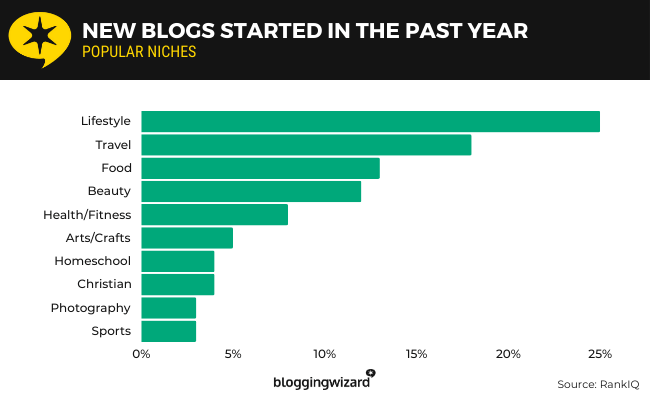
Source: RankIQ
Statistics on blogging teams
36. 68% of bloggers use an informal editing process
According to Orbit Media’s survey of over 1,000 bloggers, the majority, or 68%, use an informal editing process.
This means 32% use a formal editing process.
This basically translates into bloggers who edit posts themselves (informal) and bloggers who have at least one editor (formal).
Source: Orbit Media
37. 56% of guest bloggers write for multiple sites
ReferralRock conducted a study on guest bloggers and discovered that 56% of guest bloggers write blog content for multiple sites.
Only 7% write for a single site.
Source: ReferralRock
38. The average guest blogger makes 25.8 pitches per month
According to ReferralRock’s survey of guest bloggers, the average guest blogger sends 25.8 guest blog pitches per month.
The majority, or 50%, send one to 10 pitches per month.
27% send 11 to 25, and 16% send 26 to 100.
7% send over 100 guest blog pitches every month.
Source: ReferralRock
39. Although 85.33% of guest bloggers handle outreach tasks, only 52% actually write the posts they pitch
ReferralRock’s guest bloggers report revealed an interesting statistic.
They discovered that 87% of guest bloggers come up with ideas for guest posts.
Also, 85% search for potential sites to pitch to while 84% handle outreach campaigns themselves.
And yet, only 52% of guest bloggers actually write the posts they pitch.
This is because some guest bloggers are freelancers while others work for some sort of agency that offers content writing services.
Source: ReferralRock
40. On average, guest bloggers write 6.6 guest posts per month
ReferralRock’s data on guest bloggers states that guest bloggers write an average of 6.6 posts per month.
The majority, or 60%, write between one and five guest posts per month.
27% write between six and 10, and 10% write between 11 and 25.
3% write over 25 guest posts per month.
Source: ReferralRock
AI in blogging statistics
41. 65% of bloggers use AI
The majority of bloggers, or 65%, use artificial intelligence (AI) technology in some format.
43% use it to generate ideas, 29% use it to write headlines and 28% use it to write outlines.
Here are other common uses for AI among bloggers:
- Generate ideas – 43% of bloggers who use AI use it for this reason
- Write headlines – 29%
- Write outlines – 28%
- Suggest edits – 22%
- Write first drafts – 21%
- Write promotional social posts – 17%
- Write promotional emails – 9%
- Create visuals – 6%
- Write complete drafts – 3%
Source: Orbit Media
42. 45% of marketers who use AI to create content use it for ideas and inspiration
According to HubSpot’s latest marketing report, of marketers who use AI for content, 45% use it for content ideas and inspiration.
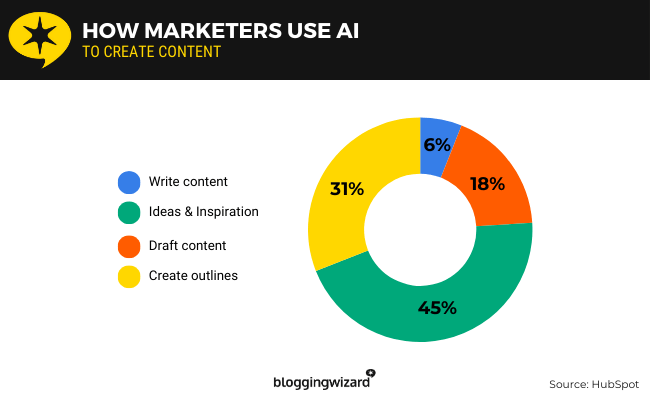
31% use it to create outlines, and 18% use it to draft content.
6% use AI to write content.
Source: HubSpot2
43. 85% of marketers who use generative AI to create content say that AI improves content quality
HubSpot asked marketers who use generative AI to create content about the benefits they’ve experienced with the technology.
85% believe generative AI will have a transformative impact this year.
Another 85% say that AI has helped improve the quality of their content.
Here are other benefits content marketers have had with generative AI:
- 84% of marketers say that generative AI tools have made them more efficient at creating content.
- 82% say AI increased their capabilities for content production.
- 77% say AI has helped them create personalized content.
Source: HubSpot2
Sources
- Allied Market Research
- WebTribunal
- HubSpot1
- Orbit Media
- Backlinko1
- HubSpot2
- RankIQ
- Content Marketing Institute
- HubSpot3
- Backlinko2
- ReferralRock
Final thoughts
That wraps up our latest collection of blogging statistics.
We learned that blogging is still a vital component of a well-rounded content marketing strategy.
We also learned a few tips on how to optimize posts, including sticking with longer posts that are at least 1,500 words in length and including some aspect of our target keywords in title tags.
Also, AI in blogging is inevitable, but at the moment, successful marketers seem to be using it as a tool to enhance their own blogging efforts rather than using it to create purely AI-generated and AI-edited blog content.
Be sure to check out our post on blog tips if you need more help optimizing your own blog.
If you haven’t started your blog yet, be sure to check out our comparison of blogging platforms, and our tutorial on how to start your own blog.

